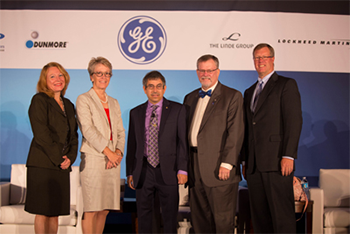How to Recruit, Retain and Inspire the Next Generation of Aerospace Engineers Written 29 July 2015
Panelists: Moderator Mark Lewis, Science and Technology Policy Institute; Steve Gorrell, Brigham Young University; Mike Hawes, Lockheed Martin Corp.; Carole Hedden, Aviation Week & Space Technology; Yvette Weber, U.S. Air Force/p>
by Ben Iannotta, Editor-in-Chief, Aerospace America

Data shows that the aerospace industry is having trouble keeping young technical talent, and panelists at the 2015 AIAA Propulsion and Energy Forum discussed ways to address that problem.
“It’s a true statement that you are only as good as your people,” said Mark Lewis, director of the Science and Technology Policy Institute, at the start of the “Workforce Development” session.
Carole Hedden, the editorial director at Aviation Week & Space Technology, defined the scope of the problem by listing statistics from the latest Aviation Week workforce study, of which AIAA is a participant. She said that each year, 5.7 percent of the workforce decides to leave aerospace.
“It’s questionable whether that’s actually a healthy rate,” Hedden said.
On top of that, “the vast majority of people choosing to leave are the newbies,” she said, meaning people with less than five years in the industry.
Also, the No. 1 impetus cited for joining the aerospace industry was not an aircraft, satellite or rocket project, but Elon Musk’s Tesla Motors, she added.
One panelist diagnosed that “young people want to be in charge of their destiny,” and she called for a shift in thinking about work-life balance. Today, some employers “subliminally” signal their employees that “time in the office is better and leads to advancement,” said Yvette Weber, the developmental system chief for the U.S. Air Force C-5 fleet. “We have to actively work to change that culture to be more results-oriented,” she said. Some companies are even shifting to unlimited vacation time, she noted, in the belief that this will focus employees on results.
Too often, she said, work-life balance is narrowed to an issue of women and child-rearing. “Work-life balance goes beyond that type of activity.”
The panelists said another key issue is the crushing student-loan burden. Hedden said these loans are not the 3-percent interest versions of previous generations, but loans with 7- to 8-percent interest rates that require large payments.
“This is a big issue,” she said. Unlike companies like Google, Amazon and Apple, companies in the aerospace sector do not typically provide large signing bonuses to wipe out a significant portion of education debt, Hedden added.
In the area of training, some companies have cited shortcomings in new-employee critical thinking and teamwork. Steve Gorrell, an associate professor at Brigham Young University, said he is seeing progress toward addressing that through the unmanned-aircraft initiative for students run by the Aerospace Partners for the Advancement of Collaborative Engineering.
“We focus on multidisciplinary design,” he said. The students break into teams that design and build different parts of a small unmanned aircraft, integrate the components and then fly the plane. “What we’re finding from this [initiative] is that it’s helping to narrow that skills gap between academia and industry that’s been identified,” Gorrell said.
On the topic of retention, the panel suggested that there is no substitute for involving engineers in fascinating, high-stakes work. Lockheed Martin’s Mike Hawes, vice president and Orion program manager with Space Systems, said the company has had no trouble retaining talent to design and build NASA’s multibillion-dollar crew capsules.
“I frankly expected a fairly high rate moving off Orion after our test flight in December. Frankly, we didn’t see a very high transition rate from that, and that’s very helpful to the program,” Hawes said, referring to the space test of an unmanned Orion capsule last year.
That said, Hedden said engineers typically want to move to other roles every 24 to 36 months, according to the workforce study. They don’t mind working on one kind of plane for decades, she said, but they want a change of tasks.
